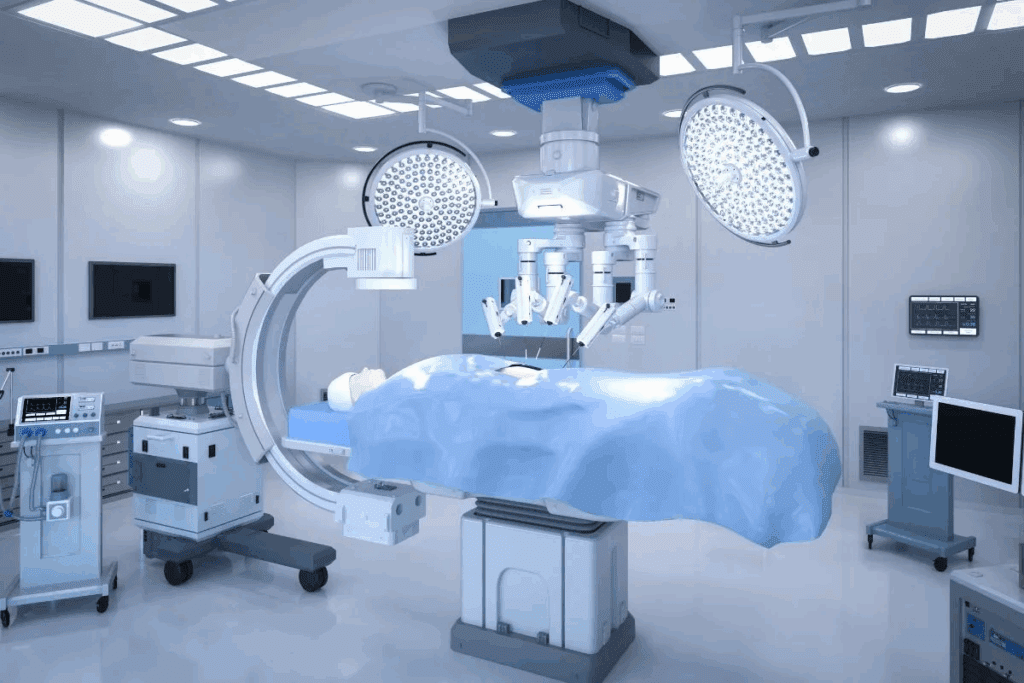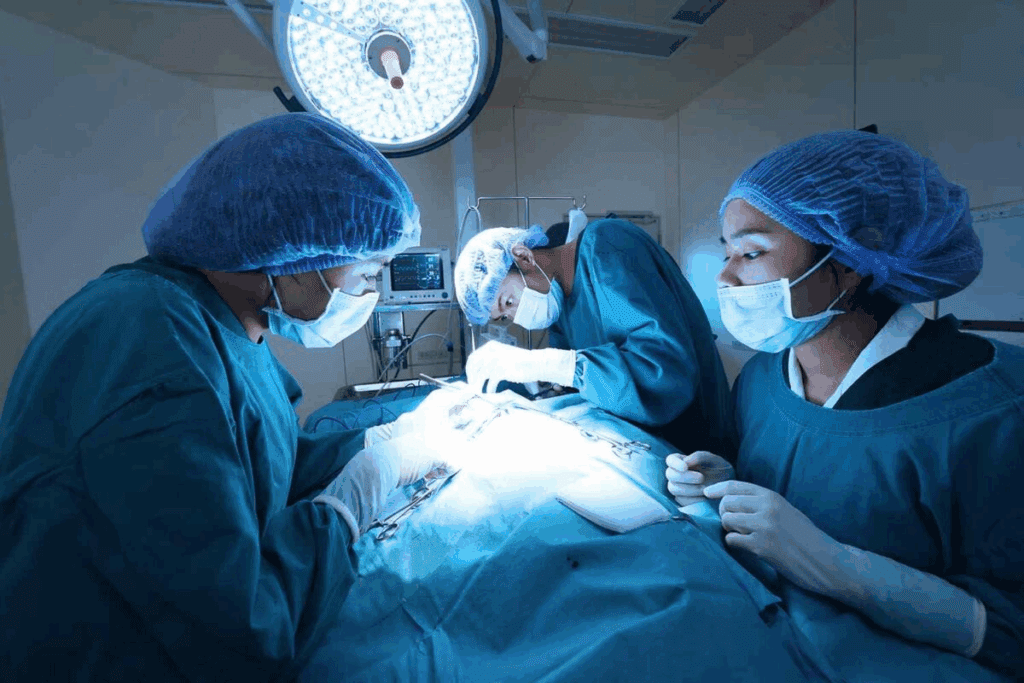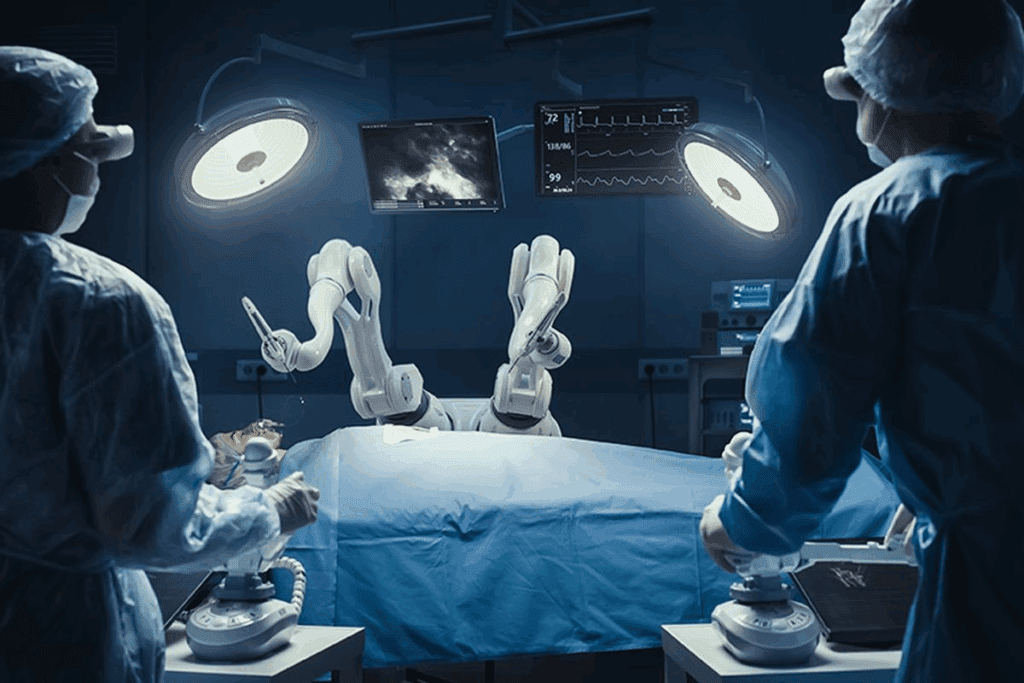Last Updated on November 27, 2025 by Bilal Hasdemir

Robotic heart surgery is transforming modern medicine by allowing surgeons to perform complex procedures through small incisions instead of large cuts. More than 100,000 robotic surgeries have been performed globally, many of which involve heart procedures.
This innovative approach, often compared to a heart transplant without opening chest, offers major benefits such as reduced pain, smaller scars, and shorter hospital stays. However, it also comes with certain limitations that need to be considered.
As technology continues to advance, understanding both the advantages and risks of robotic cardiovascular surgery becomes essential for patients and healthcare professionals alike.

Cardiac surgery has seen a lot of changes over time. It started with open-heart surgery and now includes robotic-assisted procedures. These changes aim to make surgery less painful, reduce recovery time, and improve results.
Older open-heart surgery required a big cut in the chest. This caused a lot of damage and a long recovery. Now, minimally invasive cardiac surgery uses smaller cuts, leading to less damage and faster healing.
These new methods have shown great results. Patients feel less pain, stay in the hospital less, and get back to their lives sooner. This makes minimally invasive surgery a popular choice for many.
Robotic technology has brought a new level to cardiac surgery. Robotic cardiac surgery uses a system like the da Vinci Surgical System. It lets surgeons do complex tasks through small cuts.
Robotic cardiac surgery is a big step forward in treating heart problems. It combines new technology with skilled surgeons. This could lead to even better results and shorter recovery times.

Robotic heart surgery technology is changing cardiac surgery. It brings better precision and control. This new tech has made complex surgeries more accurate and less invasive.
The da Vinci Surgical System is a top choice for cardiac surgery. It gives surgeons a clear, 3D view and precise control. Other robotic systems are also being used, expanding what’s possible in robotic heart surgery.
Robotic systems help cardiovascular surgeons a lot. They offer advanced tools and tech. The surgeon’s console is key, with enhanced visualization and precise control over the robotic arms.
The surgeon’s console is easy to use. It lets surgeons control the robotic arms with great precision. It also has high-definition 3D visualization, so surgeons can see everything clearly.
The robotic arms have special instruments for surgery. These instruments move like a human hand, for precise dissection and suturing. The arms can also rotate and move in many ways.
| Feature | Description | Benefit |
| High-Definition 3D Visualization | Provides a clear and detailed view of the operating area | Enhanced precision and accuracy |
| Ergonomic Console | Designed for comfort and intuitive control | Reduced surgeon fatigue |
| Robotic Arms and Instruments | Mimics human hand movements with precision | Precise dissection and suturing |
Robotic cardiac surgery has changed how we treat heart problems. It offers patients less invasive options. This new way of cardiac care lets surgeons do complex tasks with better precision and accuracy.
Robotic CABG is a new, less invasive surgery for blocked arteries. It uses robotic systems to help bypass these blockages. This method causes less damage and leads to quicker recovery times than traditional surgery.
Surgeons can work with more precision because of the robotic technology. This technology gives them better vision and control during the surgery.
Robotic valve repair and replacement use robotic systems to help fix or replace heart valves. This method lets surgeons do delicate repairs with greater accuracy and less invasion. The robotic tools help with precise cutting and stitching, improving patient results.
Robotically assisted atrial fibrillation treatment uses robots for surgical ablation. This aims to fix an irregular heart rhythm. It’s a less invasive way to treat this condition, reducing risks from traditional surgery.
The robotic technology’s precision allows for targeted treatment. This minimizes harm to other tissues.
Robotic technology has greatly increased treatment options for heart conditions. It helps surgeons offer safer, more effective treatments. This improves patients’ quality of life.
A new way in heart surgery lets doctors transplant hearts without opening the chest. This method uses robots to make the surgery less invasive. It could mean less time in the hospital and less scarring for patients.
The surgery starts with advanced robots, like the da Vinci Surgical System. These robots help surgeons do detailed work. Robotic heart transplant surgeries use small cuts for the robots to work through.
It takes a skilled team to do this surgery. Totally endoscopic coronary artery bypass (TECAB) is one example of a successful robotic-assisted procedure.
TECAB is a complex surgery for blocked heart arteries. It’s done through small openings, not a big cut. Robotic TECAB helps with precise grafting and stitching. This could lead to better results for heart disease patients.
Robotic heart transplants and TECAB are big steps forward. But, they’re not used as much yet. Surgeons need special training, and the robots are expensive.
Despite these hurdles, the benefits are clear. Heart transplant without opening chest means less harm, fewer complications, and quicker healing. As technology gets better, we’ll see more in robotic heart surgery.
Robotic heart surgery is changing how we treat heart problems. It brings many benefits, like less pain, quicker healing, and better looks.
Robotic heart surgery is kinder to the body. It uses smaller incisions to cause less damage. This means patients feel less pain and heal faster.
Robotic systems help surgeons see and do more. They offer enhanced visualization and precision. This makes complex surgeries safer and more effective.
The look of robotic heart surgery is a big plus. The smaller incisions mean less scarring. This makes patients happier with their results and helps them get back to life faster.
Robotic systems make surgery less invasive. This leads to minimally invasive procedures with smaller cuts. It lowers the risk of infection and makes scars less noticeable.
People who have robotic heart surgery get back to normal fast. The surgery is less invasive, so they heal quicker. This means less time off from daily life.
| Advantages | Benefits | Outcomes |
| Reduced Trauma | Less tissue damage, less post-operative pain | Faster recovery, less discomfort |
| Enhanced Precision | More accurate procedures, better visualization | Improved surgical outcomes, reduced complications |
| Cosmetic Benefits | Smaller incisions, reduced scarring | Better cosmetic outcomes, higher patient satisfaction |
Robotic heart surgery has its own set of challenges and limitations. As it evolves, it’s important for doctors and patients to know about these drawbacks.
Robotic heart surgery is very complex for surgeons. It requires a lot of training and experience. Surgeons need to learn to work in a three-dimensional space through a console, which is different from traditional surgery.
The da Vinci Surgical System, a common robotic platform, needs precise hand-eye coordination and fine motor control. Achieving this skill takes a lot of practice and experience, making the first cases very challenging.
Robotic heart surgery is expensive. The cost of the equipment and maintenance is high. The cost per procedure also goes up because of the need for specialized training.
This high cost can make robotic heart surgery less accessible. It’s a problem for healthcare systems with limited budgets.
Robotic heart surgery, like any surgery, has risks and complications. These can include general surgical risks like infection and bleeding. There are also specific risks related to the robotic technology.
One big risk is needing to switch to open surgery during the procedure. This can happen for reasons like bleeding, adhesions, or equipment failure. Switching to open surgery can make recovery longer.
There are also complications specific to the robotic system. These can include mechanical failures or issues with the instruments. While rare, these can have serious consequences, highlighting the need for strict safety and maintenance protocols.
In conclusion, robotic heart surgery has many benefits but also challenges and limitations. Understanding these can help healthcare providers prepare for and reduce the risks of this advanced surgical technique.
Robotic systems have made cardiac surgery more precise and better for patients. They are used for many heart procedures, like bypass grafting and valve repairs.
Research shows robotic bypass surgery is very successful, with success rates over 95%. Robotic cardiac surgery makes dissections and connections more precise. This could lower the chance of complications.
A study on robotic CABG found low complication rates and quick recovery times for patients.
Studies comparing robotic cardiac surgery to traditional open-heart surgery are promising. Robotic bypass surgery causes less trauma, less blood loss, and shorter hospital stays. A study found robotic CABG patients had fewer complications and recovered faster.
The success of robotic cardiac surgery makes it a strong alternative to traditional methods. As technology improves, we can expect even better results for patients.
Choosing the right patient for robotic heart surgery is key to success. It’s about finding out if a patient is a good fit for this type of surgery.
Good candidates for robotic heart surgery are those who can benefit from less invasive methods. This includes people with coronary artery disease or valve issues. Those who have had heart surgery before and are in good health are also considered.
The da Vinci Surgical System helps avoid the big scars of open-heart surgery. Patients often feel less pain and get out of the hospital sooner. This means they can get back to their lives faster.
Robotic heart surgery is not for everyone. Severe lung disease or previous surgeries that make the robotic approach hard are not good fits. Also, those needing emergency surgery or with complex heart conditions might not be right for it.
Things like being overweight, having diabetes, or vascular disease can also make it harder. A heart specialist must carefully check each case to weigh the risks and benefits.
Robotic heart surgery is a big step forward in heart care. It brings many benefits and new ways to help patients. This technology has changed how we do heart surgery, making some procedures possible without opening the chest.
This surgery is better because it causes less damage and helps patients recover faster. It also allows for more precise work. But, it’s not perfect. There are technical hurdles and it can be expensive. Knowing these points helps decide if it’s right for someone.
As robotic tech gets better, it will help heart care even more. It offers a new way to treat heart disease that’s less invasive than old methods. This could greatly improve how we treat heart problems.
Robotic heart surgery is a new way to do heart surgery. It uses a robotic system, like the da Vinci Surgical System. This helps surgeons do complex heart procedures with less damage.
Robotic heart surgery has many benefits. It causes less trauma and leads to faster recovery. It also offers better precision and cosmetic results, improving your quality of life.
Robotic cardiac surgery can handle several procedures. These include Coronary Artery Bypass Grafting (CABG), valve repair and replacement, and treatments for atrial fibrillation.
Robotic heart surgery is generally safe. But, like any surgery, it comes with risks and complications. One risk is needing to switch to open surgery.
TECAB surgery is a special robotic cardiac surgery. It does coronary artery bypass grafting without opening the chest.
The best candidates for robotic heart surgery have specific heart conditions. They should also be in good overall health.
Robotic heart surgery has many advantages over traditional surgery. It causes less trauma, less pain, and leads to faster recovery. But, it’s not right for everyone.
Robotic bypass surgery has a high success rate. It’s often as good as, or even better than, traditional CABG surgery. But, results can vary.
Insurance coverage for robotic heart surgery varies. It depends on the insurance provider and policy. Always check with your insurance company.
Robotic heart surgery can cost more than traditional surgery. This is because of the robotic system and surgeon training. Costs can vary based on location and other factors.
Robotic heart surgery is being explored for heart transplants. It aims to do transplants without opening the chest. But, this is a developing area and not yet widely available.
Subscribe to our e-newsletter to stay informed about the latest innovations in the world of health and exclusive offers!